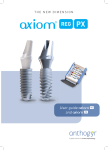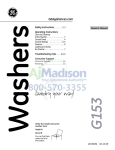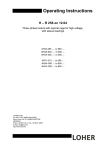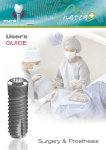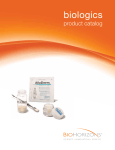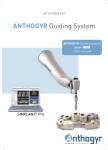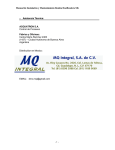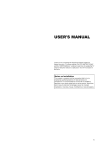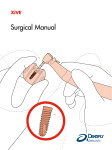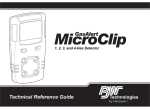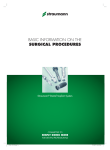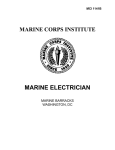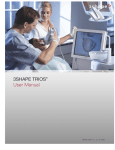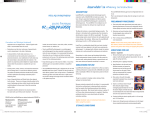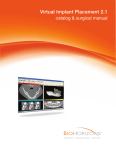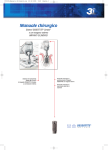Download External Product Catalog and Technique Manual 2007
Transcript
External Product Catalog and Technique Manual 2007 ORDERING & WARRANTY INFORMATION Product Support Specialist: Cell phone: Fax: BioHorizons USA Customer Care/Servicio al Cliente: 888-246-8338 / 205-967-7880 BioHorizons Canada Customer Care/Service à la Clientèle: 866-468-8338 / 905-944-1700 BioHorizons Ibérica Atención al Cliente: +34 91 713 10 84 BioHorizons GmbH Kunden Service: +49 7661-909989-0 BioHorizons UK Customer Care: +44 8700 620 550 BioHorizons No Exceptions Lifetime Warranty on Implants and Prosthetics: BioHorizons implants and prosthetic components carry a Lifetime Warranty. We will replace any BioHorizons implant or prosthetic component if removal of that product due to failure (excluding normal wear to overdenture attachments) is required for any reason, at any time. Warranties on Instruments, Surgical Drills, Taps and Torque Wrenches: BioHorizons warranties instruments, surgical drills and taps and torque wrenches for the period specified for each in (1) & (2) below. During the specified warranty period we will replace or repair any product with a defect in material or workmanship. (1) Instruments: The warranty on BioHorizons instruments extends for a period of one (1) year from the date of initial invoice. This includes drivers, sinus lift components, implant site dilators and other BioHorizons tools used in the placement or restoration of our implants, with the exception of surgical drills and taps (see below). Torque wrenches require recalibration every 12 months. BioHorizons Customer Care can provide information on where to send your wrenches for recalibration and service. (2) Surgical Drills and Taps: Surgical drills and taps are covered by warranty for a period of 90 days from the date of initial invoice. Surgical drills and taps should be replaced when they are worn, dull, corroded or in any way compromised. BioHorizons recommends the replacement of drills after 12 to 20 osteotomies.1 Return Policy: Instructions for initiating returns can be found on the reverse side of the invoice that was shipped with the product. Please contact Customer Care if you need a copy of the instructions or if you have additional questions or requests. BioHorizons strongly recommends completion of postgraduate dental implant education and strict adherence to the Instructions for Use (IFU) that accompany our products. Treatment planning and use of the products are solely your responsibility. BioHorizons is not responsible for incidental or consequential damages or liability relating to use of our products alone or in combination with other products, other than replacement or repair under our warranties. BioHorizons continually strives to improve its products and therefore reserves the right to improve, modify, change specifications or discontinue products at any time. TABLE OF CONTENTS Ordering and Warranty Information Icon Legend Section 1: Product Catalog External System Overview Implants Healing Abutments and Cover Screws Surgical Kit and Components Ancillary Instruments and Literature W&H Surgical Motors and Handpieces Abutment Overview Cement-retained 3inOne™ and PEEK Temporary Abutments Angled Abutments Profile Abutments Straight and One-piece Abutments Titanium Temporary Abutments Custom-castable (UCLA) Restorations Impression Component Overview Indirect Transfer Copings Direct Impression Copings Implant Analogs and Screws Abutment for Screw Restorations Ball Abutment Restorations Prosthetic Instrumentation Patient Education and Practice Marketing Section 2: Surgical Manual Implant Dimensions Introduction, Treatment and Surgical Protocols Implant Spacing / Intraoral Measurements Radiographic Template Surgical Kit Layout Drill and Placement Overview Osteotomy Initialization and Verification Depth and Width Increasing Drills Crestal Bone Drills and Bone Taps Implant Packaging Implant Placement Cover Screws and Healing Abutments Bone Profilers Post-operative Instructions / Surgical Kit Cleaning Drill Instructions for Use References page b 2 4-5 6 7 8-9 10-11 12-13 14 15 16 17 18 19 20-21 22 23 24 25 26-27 28-29 30-31 32 33 34-35 36-37 38 39 40-41 42-43 44-45 46-47 48-49 50-51 52 53 54-55 56-57 57 ICON LEGEND Implant diameter : surface treatment Ø3.5 Ø3.5mm Implant: RBT Ø4.0 Ø4.0 Ø5.0 Ø5.0 Ø6.0 Ø6.0 Ø4.0mm Implant: RBT/HA Ø5.0mm Implant: RBT/HA Ø6.0mm Implant: RBT/HA Symbol descriptions for product labeling LOT Lot/batch number REF Reference/article number Manufacture date Single use only STERILE R Sterilization by gamma irradiation Refer to Instructions for Use NON-STERILE Non-sterile Use before expiration date Rx Only Caution: Federal (USA) law restricts these devices by, or on the order of, a dentist or physician. BioHorizons products carry the CE mark and fulfill the requirements of the Medical Devices Directive 93/42/EEC Disclaimer of Liability BioHorizons dental implants may only be used in conjunction with the associated original components and instruments according to BioHorizons Instructions for Use. Use of any non-BioHorizons products in conjunction with BioHorizons implants will void any warranty or any other obligation, expressed or implied, of BioHorizons. This literature serves as a reference for BioHorizons External implants, prosthetics and instrumentation. It is not intended to describe the methods or procedures for diagnosis, treatment planning, or placement of implants, nor does it replace clinical training or a clinician’s best judgment regarding the needs of each patient. BioHorizons recommends appropriate training as a prerequisite for the placement of implants and associated treatment. Validity Upon its release, this literature supersedes all previously published versions. Availability Not all products shown or described in this literature are available in all countries. SURGICAL Section 1: Product Catalog System Overview Implants and Healing Abutments Surgical Kit and Motors Prosthetic Components Why pay for a prepable, gold-hued esthetic abutment if you don’t have to? Most implant companies make you pay extra for a prepable esthetic abutment. Using the pre-mounted 3inOne™ Abutment keeps inventory and overhead costs to a minimum and minimizes the chance of not having the correct components to complete the case. Low-profile Abutment Screw allows for extremely low clearance. Gold-hued TiN coating for soft tissue esthetics. Prosthetic platform 0.2mm wider than implant body. Industry standard .050” hex. Stable 1mm high external hex. 0.5mm machined collar. Spiralock® technology virtually eliminates screw loosening. Stated implant length. Patented Guide Pin saves time and eliminates cross threading. Implant body diameter. Crestal bone maintenance leads to success A prospective, multicenter trial showed a 5-year cumulative success rate of 99.5% for 495 External implants in 151 patients. There were no significant differences in the results by center, implant type, bone density, area of the mouth or prosthesis type. Crestal bone loss from prosthesis delivery to one-year follow-up was extremely low (0.06mm), and actually turned into bone gain at later follow-up intervals.2 Radiographs of External implants in function for more than 6 years. Note that the crestal bone levels are maintained above the level of the first thread. Radiographs courtesy of Dr. Carl E. Misch. Increased surface area for immediate loading success Bone is strongest in compressive loading; weakest in shear. External’s modified square-thread design imparts 10 times less destructive stresses at the implant / bone interface than conventional v-thread designs, while maximizing compressive load transfer and providing excellent primary stability. These attributes have become increasingly important with the emergence of early and immediate load protocols.3,4,5 The square-thread design provides up to 154% greater surface area than conventional v-thread designs. A comparative study of thread designs (square-thread, v-thread and buttress thread) concluded that the square-thread design exhibited significantly higher reverse torque values and bone-to-implant contact than the other thread designs.6 BioHorizons square-thread Conventional v-thread More production with less chair time The 3inOne Abutment may be used with the Ball-top Screw to make an indirect impression at the time of surgical placement or at second-stage uncovery. This permits the lab to prepare the abutment and fabricate a provisional crown in advance of the next appointment, allowing the case to be completed with fewer appointments and less chair time. IMPLANTS BioHorizons External Implants Each implant is packaged with the 3inOne Abutment, Cover Screw and Abutment Screw. Choice of RBT or HA surface treatment (except Ø3.5mm RBT only). Order by length and diameter. Titanium Alloy [Ti-6Al-4V]. All External Implants have a 0.5mm machined collar between the implant/abutment interface and the top of the RBT or HA surface treatment. Resorbable Blast Texturing (RBT) Pure TiO2 surface 60µ Ra Hydroxylapatite Coating (HA) High-density crystalline coating RBT Surface Diameter x Length 3509D3 Ø3.5mm x 9mm 35105D3 Ø3.5mm x 10.5mm 3512D3 Ø3.5mm x 12mm 3515D3 Ø3.5mm x 15mm RBT Surface Diameter x Length HA Surface 4009D3 Ø4.0mm x 9mm 4009D4 40105D3 Ø4.0mm x 10.5mm 40105D4 4012D3 Ø4.0mm x 12mm 4012D4 4015D3 Ø4.0mm x 15mm 4015D4 RBT Surface Diameter x Length HA Surface 5009D3 Ø5.0mm x 9mm 5009D4 50105D3 Ø5.0mm x 10.5mm 50105D4 5012D3 Ø5.0mm x 12mm 5012D4 5015D3 Ø5.0mm x 15mm 5015D4 RBT Surface Diameter x Length HA Surface 6009D3 Ø6.0mm x 9mm 6009D4 60105D3 Ø6.0mm x 10.5mm 60105D4 6012D3 Ø6.0mm x 12mm 6012D4 6015D3 Ø6.0mm x 15mm 6015D4 *parts shown not to scale HEALING ABUTMENTS AND COVER SCREWS Healing Abutments Used for tissue healing at second-stage uncovery or as the transmucosal element for a single-stage procedure. The Suture Groove allows the surgeon to apically position the soft tissue flap and retain it in this position for improved esthetic results. Hand-tighten with the .050” (1.25mm) Hex Driver. Titanium Alloy [Ti-6Al-4V]. Flared Emergence Profile – Healing Abutment Flared Emergence Profile Healing Abutments should be used whenever mesial / distal space permits and use of an abutment with a flared margin is planned. The margin profile contours the tissue away from the implant platform and allows easier seating of flared abutments on the implant prosthetic platform. Approximately 1mm wider than the prosthetic platform of the corresponding implant. 212-303 Ø3.5mm x 3mm 212-503 Ø5.0mm x 3mm 212-304 Ø3.5mm x 4.5mm 212-504 Ø5.0mm x 4.5mm 212-306 Ø3.5mm x 6mm 212-506 Ø5.0mm x 6mm 212-403 Ø4.0mm x 3mm 212-603 Ø6.0mm x 3mm 212-404 Ø4.0mm x 4.5mm 212-604 Ø6.0mm x 4.5mm 212-406 Ø4.0mm x 6mm 212-606 Ø6.0mm x 6mm Straight Emergence Healing Abutment Straight Emergence Healing Abutments have the same diameter as the corresponding implant platform. Proper seating of the 3inOne Abutment and other flared emergence abutments may be difficult if the Straight Emergence Healing Abutment is used. In these cases, the 3inOne Abutment should not be used as an impression coping. All other BioHorizons impression copings will work for these cases. Be sure that the coping used is appropriate for the specific case (hexed or non-hexed). 204-303 Ø3.5mm x 3mm 204-503 Ø5.0mm x 3mm 204-304 Ø3.5mm x 4.5mm 204-504 Ø5.0mm x 4.5mm 204-306 Ø3.5mm x 6mm 204-506 Ø5.0mm x 6mm 204-403 Ø4.0mm x 3mm 204-603 Ø6.0mm x 3mm 204-404 Ø4.0mm x 4.5mm 204-604 Ø6.0mm x 4.5mm 204-406 Ø4.0mm x 6mm 204-606 Ø6.0mm x 6mm Cover Screws Protects the implant’s prosthetic platform during submerged surgical healing. Included with each implant system. Hand-tighten with the .050” (1.25mm) Hex Driver. Titanium Alloy [Ti-6Al-4V]. 103-900 Ø3.5mm Cover Screw 104-900 Ø4.0mm Cover Screw 105-900 Ø5.0mm Cover Screw 106-900 Ø6.0mm Cover Screw *parts shown not to scale SURGICAL KIT AND COMPONENTS External Surgical Kit 160-500 External Surgical Kit Includes all instruments shown on pages 8-9. 160-200 Surgical Tray & Lid (without instruments) Individual Surgical Kit Components 122-103 122-100 144-100 Straight Parallel Pins (4 per kit) 2.0mm Starter Drill Drill Extender 144-200 20° Angled Parallel Pins (2 per kit) 122-12509 2.5 x 9mm Depth Drill 122-125105 2.5 x 10.5mm Depth Drill 122-12512 2.5 x 12mm Depth Drill 122-12515 2.5 x 15mm Depth Drill 122-225 2.5mm Depth Drill (without Depth Stop) 122-230 3.0mm Width Increasing Drill 122-232 3.4mm Width Increasing Drill 122-237 3.9mm Width Increasing Drill 122-242 4.4mm Width Increasing Drill 122-247 4.9mm Width Increasing Drill 122-252 5.4mm Width Increasing Drill *parts shown not to scale SURGICAL COMPONENTS 123-000 3.5mm Crestal Bone Drill 123-300 3.5mm D3 Bone Tap 124-000 4.0mm Crestal Bone Drill 124-300 4.0mm D3 Bone Tap 125-000 5.0mm Crestal Bone Drill 125-300 5.0mm D3 Bone Tap 126-000 6.0mm Crestal Bone Drill 126-300 6.0mm D3 Bone Tap 133-100 3.5mm Handpiece Adapter 303-200 3.5mm Ratchet Adapter 145-100 4.0/5.0/6.0mm Handpiece Adapter 345-200 4.0/5.0/6.0mm Ratchet Adapter 153-000 3.5mm Implant-level Insertion Tool 154-000 4.0mm Implant-level Insertion Tool 155-000 5.0/6.0mm Implant-level Insertion Tool 135-351 .050” (1.25mm) Hex Driver 130-000 Ratchet 300-400 Hand Wrench 144-300 Implant Spacer / Depth Probe 300-205 Ratchet & Hand Wrench Extender *parts shown not to scale ANCILLARY INSTRUMENTS AND LITERATURE Surgical Driver 150-000 Surgical Driver Used to place implants in the osteotomy; particularly useful in the anterior. The Driver holds the Ratchet Adapters (303-200 and 345-200) that interface with the 3inOne Abutment. Also used with the .050” (1.25mm) Hex Drivers (300-350 and 300-351), as well as the Bone Taps and Insertion Tools. Radiographic Templates L0250 BioHorizons External Radiographic Implant Template (overlay) Designed to aid the clinician in the preoperative determination of options for implant length and diameter. The clear overlay template shows all sizes of BioHorizons External implants in 100% and 125% scale. Tissue Punches 122-201 3.5/4.0mm Tissue Punch 122-202 5.0mm Tissue Punch 122-203 6.0mm Tissue Punch BioHorizons Tissue Punches are used in a latch-type handpiece to remove the soft tissue from the crest of the ridge prior to osteotomy preparation in a flapless surgical procedure. Available in 3 diameters. Bone Profiling Burs 122-113 3.5mm Bone Profiling Bur 122-114 4.0mm Bone Profiling Bur 122-115 5.0mm Bone Profiling Bur 122-116 6.0mm Bone Profiling Bur Used at implant uncovery to contour crestal bone to accommodate abutments when the implant is subcrestal. For use in latch-type reduction handpieces. The Profiler’s internal geometry matches the geometry of the surgical Cover Screw which aligns the Profiler for precise removal of tissue surrounding the platform. Diameters correspond to the 4 External implant diameters. 10 *parts shown not to scale ANCILLARY INSTRUMENTS AND LITERATURE 2.0mm Lindemann Bone Cutter 122-110 2.0mm Lindemann Bone Cutter Side-cutting drill used to correct eccentric osteotomy preparations. Clean-out Tap Tools 123-001 3.5mm Implant Clean-out Tap Tool 124-001 4.0/5.0/6.0mm Implant Clean-out Tap Tool 122-170 Abutment for Screw Clean-out Tap Tool Used to re-thread External implants or Abutments for Screw where the internal threads have become damaged. Requires a standard surgical Ratchet (130-000) or Hand Wrench (300-400) as a drive mechanism. Related Literature ML0203 BioHorizons Regeneration Product Catalog Ordering information on AlloDerm®, Grafton DBM®, MinerOss®, the Bone Fixation Screw Kit and AutoTac® Titanium tacking system. Also shown are a wide array of bone and softtissue grafting instruments. L0130 BioHorizons External Surgical Kit Wall Chart 11’’ x 17’’ (28cm x 43cm) wall chart details the location of instruments in the External Surgical Kit (ref. 160-500), as well as the reference numbers to assist re-ordering. Packaged with each new surgical kit, but also available upon request. L0131 BioHorizons External Depth Mark and Drill Sequence Chart 11’’ x 17’’ (28cm x 43cm) wall chart details the Drill Depth Marks and recommended sequence of use for the instruments found in the External Surgical Kit (ref. 160-500). Packaged with each new surgical kit, but also available on request. 11 *parts shown not to scale W&H MOTORS & ACCESSORIES W&H ImplantMed 915 WH-915 W&H ImplantMed 915 Starter Kit Re-order items: WH-ITC915 WH-IC WH-915MC WD-79M WH-915 One-piece Disposable Irrigation Set (6 pack) Irrigation Clip for WI-75MB Handpiece ImplantMed 915 Motor Cable - 1.8 meter W&H Endo Contra-Angle 2:1 Handpiece WD-79 Not included in Starter Kit. 2:1 speed-reducing ratio. Used with ImplantMed 915 for mechanical root canal preparation. Maximum motor speed is 40,000 rpm. The motor comes with the WI-75MB 20:1 handpiece, bur testing gauge, (3) disposable irrigation assemblies (WHITC915, order replacements above), and service oil. The starter kit has factory-programmed settings for endodontic functions when used with the W&H Endo Contra-angle 2:1 Handpiece (sold separately above, ref. # WD-79M). W&H ElcoMed SA-200 WH 200 W&H ElcoMed SA-200 Professional Kit Re-order items: WH-200PTWC WH-200RPT (3 PK) WH-200INI WH-200DOC WH-200MC Pump Tube (190mm) with Connectors Replacement Pump Tubes (190mm) (3 pack) INI Cards (3 pack) DOC Cards (3 pack) ElcoMed 200 Motor Cable -1.8 meter Maximum motor speed is 50,000 rpm. The SA-200 permits the storage of torque characteristics of a treatment stage, which can then be saved on a DOC card for archiving purposes. The kit also includes the WS-75 20:1 handpiece, (10) disposable spray tubes (ref. WH-ST, order replacements below), bur testing gauge, irrigation spike and service oil. Universal and Legacy Re-order Items Ref. Code Description Motor Compatibility WH-ST (10 PK) Green Single-Use Spray Tubes (10 pack) All W&H Motors WH-CLP (10 PK) WH-100PTWC WH-100RPT (5 PK) WH-100MC WH-110MC WH-110CLP (5 PK) WH-110PTWC WH-110RPT (3 PK) WH-110ISAWRC WH-110RC WH-ISA WH-ITWOS WH-MD400 WH-OSC WH-SP Set of Spray Tube Clamps (10 pack) Pump Tube with Connectors (65mm) Replacement Pump Tubes (65mm) (5 pack) ElcoMed 100 Motor Cable -1.8 meter ImplantMed 110 Motor Cable -1.8 meter Set of Spray Tube Clamps (5 pack) Pump Tube (85mm) with Connectors Replacement Pump Tubes (85mm) (3 pack) Irrigation Spike Assembly with Roller Clamp Flow Regulating Roller Clamp Irrigation Spike Assembly (autoclavable) Irrigation Tubing w/o Spike (autoclavable) ElcoMed 100 & 200 ElcoMed 100 ElcoMed 100 ElcoMed 100 ImplantMed 110 ImplantMed 110 & 915 ImplantMed 110 & 915 ImplantMed 110 & 915 ImplantMed 110 & 915 ImplantMed 110 & 915 All W&H Motors All W&H Motors All W&H Motors All W&H Motors All W&H Motors MD-400 Service Oil-F1 Oil Spray Cap Sterilization Plug for Motor Cable 12 *parts shown not to scale W&H HANDPIECES & ACCESSORIES IMPORTANT NOTE: W&H motors and handpieces are distinguished by their precision craftsmanship and reliability and are covered by a 1-year manufacturer’s warranty. Instructions for required cleaning and maintenance are outlined in each product’s user manual, and adherence to these procedures is essential for proper function and longevity of the products. BioHorizons assumes no liability for the failure of, or damage to, motors and handpieces that are not properly maintained or used contrary to the Instructions for Use. Please contact your Product Support Specialist or Customer Care at 888-2468338 (866-468-8338 in Canada) if you need additional information. W&H Surgical Handpieces WI-75MB W&H 20:1 Contra-Angle Handpiece WI-75MB Contra-Angle Handpiece with speed reduction ratio of 20:1 (2,000 rpm maximum with ImplantMed 915). Equipped for both internal cooling & external cooling. Push-button bur release. Monoblock construction. External Spray Clip (WH-IC) detaches for easy cleaning. Uses latch-type surgical drills and burs. WS-75 W&H 20:1 Contra-Angle Handpiece WS-75 Contra-Angle Handpiece with speed reduction ratio of 20:1 (2,500 rpm maximum). Equipped for both internal cooling & external cooling. Push-button bur release. Uses latch-type surgical drills and burs. WS-92 W&H 1:2.7 Contra-Angle Speed Increasing Handpiece 1:2.7 speed-increasing ratio - 135,000 rpm maximum. Contra-Angle Handpiece suitable for high speed preparation and tissue augmentation procedures. External irrigation port. Uses friction-grip burs (Ø1.6mm). S-11 W&H 1:1 Straight Surgical Handpiece 1:1 ratio - 50,000 rpm maximum. Suitable for bone harvesting, third molar extractions and osteoplasty. Easily dismantled for cleaning. Uses 45mm long friction-grip surgical burs (Ø2.35mm). S-12 W&H 1:2 Contra-Angle Surgical Handpiece 1:2 speed increasing ratio - 80,000 rpm maximum. Suitable for surgical procedures such as bone smoothing, third molar extractions and osteotomy site drilling. High precision bearings ensure that the unit runs vibration free. Uses friction-grip surgical burs at least 65mm long (Ø2.35mm). Hex Drivers for Latch-Type Reduction Handpieces 134-350 134-450 .050” (1.25mm) Handpiece Hex Driver .050” (1.25mm) Handpiece Hex Driver, Long For installation and removal of Cover Screws, Healing Abutments and Abutment Screws. Use with latch-type contra-angle handpieces: WS-75 or WI-75MB, or similar. 134-450 is 5mm longer than the 134-350. Bur Testing Gauge WH-BTG Bur Testing Gauge Used to verify the condition of latch-type burs. Burs in proper condition will fit into larger diameter hole, but will not fit into the smaller hole (marked red). Burs that fail either of these criteria are unfit for use, and may cause damage to the handpiece if used. 13 *parts shown not to scale ABUTMENT OVERVIEW 3inOne Abutments page 15 Angled Esthetic Abutments page 16 Cement-retained Cement-retained Single- or Multiple-unit Multiple-unit Angled Abutments page 16 Esthetic Abutments page 17 Profile Abutments page 17 Straight Abutments page 18 Abutments for Cement, (Non-hexed) page 18 Screw-retained (Implant-level) Screw-retained, Hybrid or Bar-retained (Implant-level) Cement- or Screwretained Provisional Single-unit Multiple-unit Single- or Multiple-unit Custom Cast (UCLA) Abutments (Hexed) page 20 PEEK Temporary Abutments page 15 Custom Cast (UCLA) Abutments (Non-hexed) page 21 Hybrid or Bar-retained Abutment-level Abutment-retained Tissue-supported Overdenture Abutments for Screw page 26 Ball Abutments page 28 14 Titanium Temporary Abutments page 19 *parts shown not to scale 3inOne & PEEK TEMPORARY ABUTMENTS 3inOne Abutments for Cement-retained Restorations - Hexed 203-311 3.5mm 3inOne Abutment 204-411 4.0mm 3inOne Abutment 205-511 5.0mm 3inOne Abutment 206-611 6.0mm 3inOne Abutment Packaged with Abutment Screw (130-300 or 140-300). Recommended final torque: 30 Ncm. Also used with Ball-top Screw as a closed-tray, hexed-timed impression coping. Gold-colored Titanium Nitride coating for tissue esthetics. Titanium Alloy [Ti-6Al-4V]. Premounted on each External implant system. Ø2.9mm Ø3.2mm Ø3.2mm 6° 8° Ø3.2mm 10° 15° 8mm 5.2mm 1.5mm Ø4.5mm Ø5.25mm Ø5.75mm Ø6.25mm PEEK Plastic Temporary Abutments - Hexed 273-000 3.5mm PEEK Temporary Abutment 274-000 4.0mm PEEK Temporary Abutment 275-000 5.0mm PEEK Temporary Abutment 276-000 6.0mm PEEK Temporary Abutment Packaged with Abutment Screw (130-300 or 140-300). Hand-tighten with the .050” (1.25mm) Hex Driver. Easily modified for fabrication of cement- or screw-retained provisional restorations (up to 30 days). A Direct Coping Screw (243-320 or 244-320, purchased separately) may be used to maintain screw access hole during fabrication of screw-retained provisional prostheses. PEEK® (PolyEtherEtherKetone) Plastic. Ø3.5mm Ø3.8mm Ø3.8mm 4° 5° Ø3.8mm 5° 7° 5mm 8mm 3.0mm Ø4.75mm Ø5.5mm Ø6.0mm Ø6.5mm Temporary Only (Screw-retained or Cement-retained) 15 *parts shown not to scale ANGLED ABUTMENTS Angled Esthetic Abutments Cement-retained Restorations - Hexed Indirect for Transfer Copings 223-313 3.5mm Angled Esthetic Abutment 224-313 4.0mm Angled Esthetic Abutment 225-313 5.0mm Angled Esthetic Abutment Packaged with Abutment Screw (130-300 or 140-300). Recommended final torque: 30 Ncm. Used to fabricate cement-retained, single- or multiple-unit prostheses. Gold-colored TiN coating for tissue esthetics. Titanium Alloy [Ti-6Al-4V]. 15° 15° 15° 9mm 3mm 1mm Ø5.8mm Ø5.9mm Ø6.5mm Angled Abutments for Cement-retained Restorations - Hexed 213-400 3.5mm Angled Abutment 214-400 4.0mm Angled Abutment 215-400 5.0mm Angled Abutment Packaged with Abutment Screw (130-300 or 140-300). Recommended final torque: 30 Ncm. Used to fabricate cement-retained, single- or multiple-unit prostheses. Titanium Alloy [Ti-6Al-4V]. 17° 20° 20° 11mm 1mm Ø3.7mm Ø4.2mm 16 Ø5.2mm *parts shown not to scale PROFILE ABUTMENTS Straight Esthetic Abutments for Cement-retained Restorations - Hexed 223-314 3.5mm Straight Esthetic Abutment 224-314 4.0mm Straight Esthetic Abutment 225-314 5.0mm Straight Esthetic Abutment Packaged with Abutment Screw (130-300 or 140-300). Recommended final torque: 30 Ncm. Used to fabricate cement-retained, single- or multiple-unit prostheses. Gold-colored TiN coating for tissue esthetics. Titanium Alloy [Ti-6Al-4V]. 9mm 3mm 1mm Ø5.8mm Ø5.9mm Ø6.5mm Profile Abutments for Cement-retained Restorations - Hexed 223-312 3.5mm Profile Abutment 224-312 4.0mm Profile Abutment 225-312 5.0mm Profile Abutment Packaged with Abutment Screw (130-300 or 140-300). Recommended final torque: 30 Ncm. Used to fabricate cement-retained, single- or multiple-unit prostheses. Titanium Alloy [Ti-6Al-4V]. 12mm 4mm 3mm Ø5.8mm Ø6.8mm 17 Ø7.4mm *parts shown not to scale STRAIGHT AND ONE-PIECE ABUTMENTS Straight Abutments for Cement-retained Restorations - Hexed 233-410 3.5mm Straight Abutment 234-410 4.0mm Straight Abutment 235-410 5.0mm Straight Abutment Used to fabricate cement-retained, single- or multiple-unit prostheses. Packaged with Abutment Screw (130-300 or 140-300). Recommended final torque: 30 Ncm. Titanium Alloy [Ti-6Al-4V]. 3° 4° 8° 10mm 4mm Ø3.7mm Ø4.2mm Ø5.2mm Abutments for Cement-retained Restorations - Non-hexed 223-208 3.5mm Abutment for Cement, Non-hexed 224-208 4.0mm Abutment for Cement, Non-hexed 225-208 5.0mm Abutment for Cement, Non-hexed One-piece, pre-tapered abutment. Non-hex engaging: multiple-unit restorations only. Best suited for restorations requiring only minor intra-oral modification. Recommended final torque: 30 Ncm. Titanium Alloy [Ti-6Al-4V]. 4° 6° 9.5° 8mm Ø3.7mm Ø4.2mm 18 Ø5.2mm *parts shown not to scale TITANIUM TEMPORARY ABUTMENTS Titanium Temporary Abutments - Hexed 233-215 3.5mm Titanium Temporary Abutment, Hexed 234-215 4.0mm Titanium Temporary Abutment, Hexed 235-215 5.0mm Titanium Temporary Abutment, Hexed Used for single-unit screw-retained provisional restorations. Knurled surface for improved mechanical bond with acrylic. Packaged with the Abutment Screw (130-300 or 140-300). Titanium Alloy [Ti-6Al-4V]. Titanium Temporary Abutments - Non-hexed 233-214 3.5mm Titanium Temporary Abutment, Non-hexed 234-214 4.0mm Titanium Temporary Abutment, Non-hexed 235-214 5.0mm Titanium Temporary Abutment, Non-hexed Used for multiple-unit screw-retained provisional restorations. Knurled surface for improved mechanical bond with acrylic. Packaged with the Abutment Screw (130-300 or 140-300). Titanium Alloy [Ti-6Al-4V]. Hexed and Non-hexed Titanium Temporary Abutments share identical external geometry. Hand-tighten with the .050” (1.25mm) Hex Driver. 9mm 0.5mm Ø4.2mm Ø4.75mm 19 Ø5.75mm *parts shown not to scale CUSTOM CASTABLE COMPONENTS Custom Castable (UCLA) Abutments - Hexed 233-227 3.5mm Gold/Plastic Custom Castable Abutment, Hexed 234-227 4.0mm Gold/Plastic Custom Castable Abutment, Hexed 235-227 5.0mm Gold/Plastic Custom Castable Abutment, Hexed 236-227 6.0mm Gold/Plastic Custom Castable Abutment, Hexed Used for single-unit screw-retained or custom abutment cement-retained restorations. Packaged with the Abutment Screw (130-300 or 140-300). Recommended final torque: 30 Ncm. Gold alloy base (60% Gold, 20% Palladium, 19% Platinum, 1% Iridium) with Delrin® burn-out sleeve. Dimensions shown below. 233-217 3.5mm Plastic Custom Castable Abutment, Hexed 234-217 4.0mm Plastic Custom Castable Abutment, Hexed 235-217 5.0mm Plastic Custom Castable Abutment, Hexed 236-217 6.0mm Plastic Custom Castable Abutment, Hexed Used for single-unit screw-retained or custom abutment cement-retained restorations. Packaged with the Abutment Screw (130-300 or 140-300). Recommended final torque: 30 Ncm. Delrin® burn-out sleeve. Dimensions shown on opposite page. Hexed and Non-hexed Gold/Plastic Custom Castable Abutments share identical external geometry. 12mm 5mm (top of alloy base) 1mm Ø4.5mm Ø5.0mm Ø6.0mm 20 Ø6.75mm *parts shown not to scale CUSTOM CASTABLE COMPONENTS Custom Castable (UCLA) Abutments - Non-hexed 233-228 3.5mm Gold/Plastic Custom Castable Abutment, Non-hexed 234-228 4.0mm Gold/Plastic Custom Castable Abutment, Non-hexed 235-228 5.0mm Gold/Plastic Custom Castable Abutment, Non-hexed 236-228 6.0mm Gold/Plastic Custom Castable Abutment, Non-hexed Used for multiple-unit screw-retained or custom cast abutment cementretained restorations. Packaged with the Abutment Screw (130-300 or 140-300). Recommended final torque: 30 Ncm. Gold alloy base (60% Gold, 20% Palladium, 19% Platinum, 1% Iridium) with Delrin® burn-out sleeve. Dimensions shown on opposite page. 233-210 3.5mm Plastic Custom Castable Abutment, Non-hexed 234-210 4.0mm Plastic Custom Castable Abutment, Non-hexed 235-210 5.0mm Plastic Custom Castable Abutment, Non-hexed 236-210 6.0mm Plastic Custom Castable Abutment, Non-hexed Used for multiple-unit screw-retained or custom cast abutment cementretained restorations. Packaged with the Abutment Screw (130-300 or 140-300). Recommended final torque: 30 Ncm. Delrin® burn-out sleeve. Dimensions shown below. Hexed and Non-hexed Plastic Custom Castable Abutments share identical external geometry. 12mm 0.5mm Ø4.2mm Ø4.75mm Ø5.75mm 21 Ø6.75mm *parts shown not to scale IMPRESSION COMPONENT OVERVIEW Single- or Multiple-unit Implant-level Multiple-unit Implant-level (Non-hexed) Cement or Screw-retained prostheses Screw-retained prostheses Ball-top Screw with 3inOne Abutment (Indirect, hexed) page 23 Direct Pick-up Coping (Hexed) page 24 Direct Pick-up Coping (Non-hexed) page 24 Indirect Transfer Coping (Non-hexed) page 23 Implant Analogs page 25 Implant Analog(s) page 25 Multiple-unit Abutment-level Hybrid or Bar-retained prostheses Multiple-unit Ball Abutment Overdenture Tissue-supported prostheses Ball Abutments (used as transfer coping) page 28 Direct Pick-up Coping, Abutment for Screw page 27 Indirect Transfer Coping, Abutment for Screw page 27 Ball Abutment Analogs page 29 Analogs, Abutment for Screw page 27 22 *parts shown not to scale INDIRECT IMPRESSION COMPONENTS Ball-top Screw for Indirect Transfer (Closed Tray) - Hexed 213-235 3.5mm Ball-top Screw 214-235 4.0/5.0/6.0mm Ball-top Screw Used with the 3inOne Abutment to form an impression coping for closedtray, hexed-timed transfers. Screws for 3.5mm implants (213-235) are colorcoded (anodized) yellow. Screws for 4/5/6mm implants (214-235) are silver (un-anodized). Hand-tighten manually or with the .050” (1.25mm) Hex Driver. Titanium Alloy [Ti-6Al-4V]. Ø4mm 3mm 11mm 8mm The Ball-top Screw MUST be used with a 3inOne Abutment to serve as an indirect transfer coping Indirect Transfer Copings (Closed Tray) - Non-hexed 243-100 3.5mm Indirect Transfer Coping, Non-hexed 244-100 4.0mm Indirect Transfer Coping, Non-hexed 245-100 5.0mm Indirect Transfer Coping, Non-hexed One-piece impression coping used for closed-tray, non-hexed transfers. Only used when the final restoration is to be a multiple-unit, non-hex engaging, screw-retained prosthesis, or for making impressions for fabrication of a custom impression tray. Hand-tighten manually or with the .050” (1.25mm) Hex Driver. Titanium Alloy [Ti-6Al-4V]. 5° 5° 7° 10mm Ø3.7mm Ø4.2mm 23 Ø5.2mm *parts shown not to scale DIRECT IMPRESSION COMPONENTS Direct Pick-up Copings (Open Tray) - Hexed 243-331 3.5mm Direct Pick-up Coping, Hexed 244-331 4.0mm Direct Pick-up Coping, Hexed 245-331 5.0mm Direct Pick-up Coping, Hexed 246-331 6.0mm Direct Pick-up Coping, Hexed Used to make an open-tray, implant-level, hexed-timed impression. Packaged with the extended Direct Coping Screw (243-320 or 244-320). Titanium Alloy [Ti-6Al-4V]. Direct Pick-up Copings (Open Tray) - Non-hexed 243-321 3.5mm Direct Pick-up Coping, Non-hexed 244-321 4.0mm Direct Pick-up Coping, Non-hexed 245-321 5.0mm Direct Pick-up Coping, Non-hexed 246-321 6.0mm Direct Pick-up Coping, Non-hexed Used to make an open-tray, implant-level, non-hexed impression. Packaged with the extended Direct Coping Screw (243-320 or 244-320). Titanium Alloy [Ti-6Al-4V]. Ø2.5mm 6mm 17mm 11mm 5mm Ø3.7mm Ø5.2mm Ø4.2mm Ø6.2mm 24 *parts shown not to scale IMPLANT ANALOGS AND SCREWS Implant Analogs 293-000 3.5mm Implant Analog 294-000 4.0mm Implant Analog 295-000 5.0mm Implant Analog 296-000 6.0mm Implant Analog Represents the External implant in a laboratory-fabricated, implant-level stone model. Titanium Alloy [Ti-6Al-4V]. Abutment Screws 130-300 3.5mm Abutment Screw 140-300 4.0/5.0/6.0mm Abutment Screw Low profile screw head. Packaged with all two-piece abutments. Screws for 3.5mm implants (130-300) are color-coded (anodized) yellow. Screws for 4/5/6mm implants (140-300) are silver (un-anodized). Utilizes the .050” (1.25mm) Hex Driver. Titanium Alloy [Ti-6Al-4V]. Direct Coping Screws 243-320 3.5mm Direct Pick-up Screw 244-320 4.0/5.0/6.0mm Direct Pick-up Screw Packaged with all Direct Pick-up Copings. Screws for 3.5mm implants (243320) are color-coded (anodized) yellow. Screws for 4/5/6mm implants (244320) are silver (un-anodized). May also be used in place of the Abutment Screw when extra length is needed, or to maintain screw access hole during fabrication of screw-retained provisional prostheses. Utilizes the .050” (1.25mm) Hex Driver. Hand-tighten or torque to 30Ncm depending on application. Titanium Alloy [Ti-6Al-4V]. 25 *parts shown not to scale ABUTMENT FOR SCREW Abutment for Screw 253-103 3.5mm Abutment for Screw, 3mm collar 253-104 3.5mm Abutment for Screw, 4mm collar 253-105 3.5mm Abutment for Screw, 5mm collar 254-103 4.0mm Abutment for Screw, 3mm collar 254-104 4.0mm Abutment for Screw, 4mm collar 254-105 4.0mm Abutment for Screw, 5mm collar 255-103 5.0mm Abutment for Screw, 3mm collar 255-104 5.0mm Abutment for Screw, 4mm collar 255-105 5.0mm Abutment for Screw, 5mm collar Used for multiple-unit restorations including: screw-retained restorations at the abutment level, cast alloy bars for overdentures and fixed/detachable (hybrid) restorations. Comes packaged with the Cover Cap (224-500). Titanium Alloy [Ti-6Al-4V]. Ø4.2mm 224-500 (2.7mm high) Ø4.2mm Ø5.2mm 254-120 1mm 255-120 3, 4 or 5mm 12mm Ø3.7mm Ø5.2mm Ø4.2mm 4.5mm Ø5.2mm Ø4.2mm Plastic Coping, Abutment for Screw 254-120 3.5/4.0mm Plastic Coping, Abutment for Screw (5 pack) 255-120 5.0mm Plastic Coping, Abutment for Screw (5 pack) May be trimmed for height. Coping Screws must be purchased separately below. Delrin®. Screw (short), Abutment for Screw 222-110 Cover Screw, Abutment for Screw 224-500 Short Bar Retention Coping Screw, Abutment for Screw (5 pack) Cover Cap, Abutment for Screw Packaged with all Abutments for Screw. Handtighten with .050” (1.25mm) Hex Driver. Titanium Alloy [Ti-6Al-4V]. Used to retain bars or prostheses fabricated from the Plastic Copings for Abutment for Screw. Utilizes the .050” (1.25mm) Hex Driver. Final torque: 30 Ncm. Titanium Alloy [Ti-6Al-4V]. 26 *parts shown not to scale ABUTMENT FOR SCREW Direct Pick-up Coping, Abutment for Screw 244-311 3.5/4.0mm Direct Pick-up Coping, Abutment for Screw 245-311 5.0mm Direct Pick-up Coping, Abutment for Screw Used to make a direct pick-up impression (open-tray) at the abutment level. Packaged with the Long Bar Retention Coping Screw, Abutment for Screw (222-111). Used only with the Abutment for Screw. Titanium Alloy [Ti-6Al-4V]. Indirect Transfer Coping, Abutment for Screw 254-200 3.5/4.0mm Indirect Transfer Coping, Abutment for Screw 255-200 5.0mm Indirect Transfer Coping, Abutment for Screw Used to make an indirect transfer (closed-tray) impression at the abutment level. Used only with the Abutment for Screw. Titanium Alloy [Ti-6Al-4V]. Analog, Abutment for Screw 254-600 3.5/4.0mm Analog, Abutment for Screw 255-600 5.0mm Analog, Abutment for Screw Used to represent the Abutment for Screw/Implant assembly in the working cast. Not for use with implant-level impressions. Titanium Alloy [Ti-6Al-4V]. Screw (long), Abutment for Screw 222-111 Long Bar Retention Coping Screw, Abutment for Screw (5 pack) Used in the lab when a longer screw is desired. Used only with the Abutment for Screw. Hand-tighten or torque to 30Ncm depending on application. Titanium Alloy [Ti-6Al-4V]. Hex Adapter, Abutment for Screw 304-210 3.5/4.0mm Hex Adapter, Abutment for Screw 305-210 5.0mm Hex Adapter, Abutment for Screw Required for placement of Abutment for Screw. May be driven by either Hand Wrench, Torque Wrench or AS123 Hand Unit. 27 *parts shown not to scale BALL ABUTMENTS Ball Abutments 263-002 3.5mm Ball Abutment, 2mm Collar 263-004 3.5mm Ball Abutment, 4mm Collar 263-006 3.5mm Ball Abutment, 6mm Collar 264-002 4.0mm Ball Abutment, 2mm Collar 264-004 4.0mm Ball Abutment, 4mm Collar 264-006 4.0mm Ball Abutment, 6mm Collar 265-002 5.0mm Ball Abutment, 2mm Collar 265-004 5.0mm Ball Abutment, 4mm Collar 265-006 5.0mm Ball Abutment, 6mm Collar Ball Abutments are used for retention of tissue-supported overdentures. They are recommended for relatively parallel implants. See below and on the facing page for attachment options. Ball Abutments may be used as indirect transfer copings for production of a working cast. Titanium Alloy [Ti-6Al-4V]. Ø2.5mm Ø5.5mm Ø5.9mm 3.2mm 3.5mm 2.6mm 5mm 2, 4 or 6mm Ø3.7mm Ø4.2mm Ø5.2mm O-Ring Attachment System Standard O-ring attachment. 260-100 O-Ring Attachment Set O-Ring encapsulator 2 Processing O-rings 2 Clinical O-rings 28 260-300 O-Ring Encapsulator Female receptacle processed into denture. Titanium. 2 per package. 260-220 Processing O-Ring Used for lab processing applications. Buna. 12 per package. 260-210 Clinical O-Ring Used for clinical applications. Silicone. 12 per package. *parts shown not to scale BALL ABUTMENTS Ball Attachment System The Ball Attachment system offers several advantages over traditional O-ring attachments. It requires less mesial/distal/buccal/lingual space and offers four (4) different levels of retention. The retention inserts can be easily changed chairside. BCAS Ball Attachment Set Includes: (1) Titanium Housing, (3) Female Nylon Inserts - white (more retention), pink (less retention), black (lab processing) and (1) Protective Disk (tissue protector for impression taking and chair-side denture pick-up) BCAHT Attachment Housings – Titanium BCCBP Castable Ball Pattern Burn-out component for fabrication of a custom bar with ball attachments. Not recommended for use with O-Ring Attachments. 2 balls per pattern. BCIST Insert Seating Tool Used to seat nylon inserts in attachment housings. BCR Reamer Used to adjust retention of nylon inserts. BCPT Paralleling Tool A laboratory tool used on a surveyor to position and wax castable balls on a bar. BCS Set of 3 tools Insert Seating Tool, Reamer and Paralleling Tool. For Resin pickup or Soldering. 2 per package. BCIB Black Nylon Insert Lab Processing and Chair-side Denture Pick-up. 2 per package. BCIG Green Nylon Insert Clinical use. 2 per package. Elastic Retention. BCIY Yellow Nylon Insert Clinical use. 2 per package. Extra Soft Retention: 1.4lb / 525g BCIP Pink Nylon Insert Clinical use. 2 per package. Soft Retention: 2.3lb / 875g BCIW White Nylon Insert Clinical use. 2 per package. Standard Retention: 3.3lb / 1250g BCDR Directional Rings Used for obtaining parallelism. 0°, 7° and 14° rings. Set of 3. Ball Abutment Analogs 260-400 3.5/4.0mm Ball Abutment Analog 260-500 5.0mm Ball Abutment Analog Used to represent the Ball Abutment/Implant assembly in the working cast. Only used in conjunction with Ball Abutments. Titanium Alloy [Ti-6Al-4V]. 29 *parts shown not to scale PROSTHETIC INSTRUMENTATION Prosthetic Instrumentation System 320-000 Complete Prosthetic Instrumentation System Includes: AS123 Hand Unit / Hand Wrench / 30 Ncm Torque Wrench / .050” (1.25mm) Hex Driver, Regular/ .050” (1.25mm) Hex Driver, Long / Hex Adapters for Abutment for Screw / Ratchet Extender / Sterilization Tray. 300-070 Prosthetic Sterilization Tray Autoclavable tray for prosthetic instrumentation (included with the 320-000). 300-100 AS123 Hand Unit Provides improved vision and easy access to prosthetic components in posterior regions of the mouth. Hand Wrench and Drivers must be purchased separately. May also be purchased as part of the 320-000 Complete Prosthetic Instrumentation System (see above). 300-430 30 Ncm Torque Wrench Used to deliver torque to prosthetic components. See the accompanying Instructions for Use for periodic recalibration requirements. 12.5mm 6.25mm 300-350 .050” (1.25mm) Hex Driver, Regular 300-351 .050” (1.25mm) Hex Driver, Long Used to drive all surgical and prosthetic components with the exception of the Abutment for Screw. 304-210 3.5/4.0mm Hex Adapter, Abutment for Screw 305-210 5.0mm Hex Adapter, Abutment for Screw Required for placement of Abutment for Screw. May be driven by either Hand Wrench, Torque Wrench or AS123 Hand Unit. 300-400 Hand Wrench Used on drive end of AS123 Hand Unit . Also fits individual Hex Drivers/Adapters and Bone Taps. 30 *parts shown not to scale PROSTHETIC INSTRUMENTATION Abutment Clamp IMPAH Abutment Clamp Used to apply counter-torque during the delivery and tightening of the Abutment Screw, shielding the bone / implant interface from potentially damaging stresses. Implant Analog Handles 293-100 3.5mm Implant Analog Handle 294-100 4.0mm Implant Analog Handle 295-100 5.0/6.0mm Implant Analog Handle Used to hold External abutments for chairside or laboratory preparation, these handles mimic the implant/analog hex geometry. Abutments are secured to the handle with the standard Abutment Screw (130-300 or 140-300). Comes in three platform sizes: Ø3.5, 4.0mm and Ø5.0/6.0mm. Collateral Marketing ML0207 BioHorizons External Impression Technique Guide Guides the clinician and laboratory through impression making techniques and prosthetic/lab procedures with the BioHorizons External impression components. M4XIM External 4x Patient Education Model This 4-times scale model includes the Implant, Abutment, Abutment Screw, Ball-top Screw, Healing Abutment, Cover Screw, Implant Driver and Hex Driver. Excellent for demonstrating implant components to the patient. Call for availability. 31 *parts shown not to scale PATIENT EDUCATION Patient Education Materials ML0131 Patient Education – Dental Implants - the tooth replacement solution This high-quality flipbook helps the implant candidate understand the rationale and the advantages of implant therapy compared to traditional treatment methods. The message focuses on the positives of implants and their ability to stop the bone loss associated with edentulism. Many treatment options are detailed to aid the clinician in describing a procedure. 9” x 6” (23cm x 16cm). ML0128 Patient Education – Tooth Replacement with Dental Implants poster This 2-sided laminated poster visually outlines the advantages of implant therapy compared to traditional treatment methods. One side focuses on tooth replacement options, while the opposite side contains information on bone loss and how dental implants can help preserve bone. 24” x 36” (61cm x 91cm). ML0103 Patient Education – If you have missing teeth... This brochure helps the implant candidate understand the rationale and the advantages of implant therapy compared to traditional treatment methods. The message focuses on the positives of implants and their ability to stop the bone loss associated with edentulism. 8.5” x 3.5” (21.5cm x 8.7cm). ML0129 Patient Education – Rebuilding and maintaining bone This brochure explains the benefits and basic science of bone regeneration and its relationship to implant therapy. 8.5” x 3.5” (21.5cm x 8.7cm). ML0114 Patient Education – Secure dentures bring back your smile This brochure helps the denture wearer understand the rationale and the advantages denture stabilization with implants. 8.5” x 3.5” (21.5cm x 8.7cm). 32 *parts shown not to scale Section 2: Surgical Manual Surgical Specifications: • Two-stage or single-stage protocols • Machined collar: 0.5mm high • Body diameters: 3.5mm / 4.0mm / 5.0mm / 6.0mm • Implant lengths: 9mm / 10.5mm / 12mm / 15mm • Prosthetic platforms 0.2mm wider than implant body • Choice of RBT or HA surface (HA not offered on Ø3.5mm implants) • Titanium Alloy (Ti-6Al-4V) Hex Flat-to-Flat distance 2.4mm 2.7mm 3.0mm 3.0mm Body Diameter 3.5mm 4.0mm 5.0mm 6.0mm Apical Diameter 2.0mm 2.1mm 2.5mm 3.5mm Minimum Ridge Width 5.5mm 6.0mm 7.0mm 8.0mm Minimum Mesial / Distal Space 6.5mm 7.0mm 8.0mm 9.0mm Implant Lengths 9mm 10.5mm 12mm 15mm 9mm 10.5mm 12mm 15mm 9mm 10.5mm 12mm 15mm 9mm 10.5mm 12mm 15mm All spacing recommendations given within this literature are general guidelines. Clinicians must apply their best judgement as to whether these guidelines are appropriate for individual patient presentations. 33 I N T R O D U C T I O N / T R E AT M E N T P L A N N I N G Introduction This Surgical Manual serves as a reference for using the BioHorizons External implants and surgical instruments. It is intended solely to provide instructions on the use of BioHorizons products. It is not intended to describe the methods or procedures for diagnosis, treatment planning, or placement of implants, nor does it replace clinical training or a clinician’s best judgment regarding the needs of each patient. BioHorizons strongly recommends appropriate training as a prerequisite for the placement of implants and associated treatment. The procedures illustrated and described within this manual reflect idealized patient presentations with adequate bone and soft tissue to accommodate implant placement. No attempt has been made to cover the wide range of actual patient conditions that may adversely affect surgical and prosthetic outcomes. Clinician judgment as related to any specific case must always supersede any recommendations made in this or any BioHorizons literature. Before beginning any implant surgical procedure with BioHorizons implants: • Design a surgical treatment plan to satisfy the prosthetic requirements of the case. • Read and understand the Instructions for Use that accompany the products. • Clean and sterilize the surgical tray and instruments per instructions. • Become thoroughly familiar with all instruments and their uses. • Study Surgical Kit layout, color-coding scheme and iconography. Treatment Planning For ideal results in implant dentistry, the treatment team should be in agreement and in communication throughout all stages of therapy. The patient, the restorative and surgical doctors, as well as the dental laboratory should understand and agree upon the treatment plan. The treatment plan should determine the design, number and position of the implants. Diagnostic Casts Mounted study casts and a diagnostic wax-up are the foundation for determining implant position. Surgical Guide Templates Once the diagnostic wax-up is finalized, the restorative doctor or dental laboratory fabricates the surgical guide template. This guide indicates to the surgeon the implant position that offers the best support for the prosthesis, as well as optimal esthetics and hygiene requirements. The surgical guide also provides information about the tooth and supporting structures that have been lost. Laboratory Guide Templates A matrix of the diagnostic wax-up may also be utilized by the laboratory when developing the final prosthesis. The matrix acts as a guide for position and contour of the prosthesis. 34 S U RG I C A L P R OTO CO L S Surgical Options Two-stage Surgery was the original protocol developed for placing modern dental implants. The implant is placed below the soft tissue and protected from occlusal function and other forces during osseointegration. A low-profile Cover Screw is placed on the implant to protect it from the ingress of soft tissue. Following osseointegration, a second surgery exposes the implant and a transmucosal Healing Abutment is placed to allow for soft tissue healing and development of a sulcus. Prosthetic restoration begins after soft tissue healing. Cover Screw in a submerged surgical protocol. Single-stage Surgery leaves the implant/abutment connection exposed to the oral cavity via a removable Healing Abutment. This eliminates the need for a second surgery to expose the implant. Although the implant is not in occlusal function, some forces can be transmitted to it through the exposed transmucosal element. Prosthetic restoration begins following osseointegration of the implant and soft tissue healing. Healing Abutment as a transmucosal element. Single-stage Surgery with Non-functional Immediate Teeth provides the patient a non-occlusal provisional prosthesis early in the treatment plan. An abutment is placed on the implant at or shortly after surgery, and a provisional restoration is secured to it with temporary cement. The provisional can help contour the soft tissue profile during healing. Non-functional provisional prosthesis. Single-stage Surgery with Immediate Function may be possible in good quality bone where multiple implants exhibiting excellent initial stability can be splinted together. Splinting implants together can offer a significant biomechanical advantage over individual, unsplinted crowns. Clinicians must evaluate the mitigating patient factors in each case to determine whether immediate function is appropriate. Splinted prosthesis in immediate function. 35 I M P L A N T S PAC I N G Spacing considerations for BioHorizons External implants: • Proper spacing is essential for esthetics, bone maintenance and hygiene considerations • Maintain a minimum of 1.5mm from adjacent teeth (contact at crest to the edge of implant) • Maintain 3.0mm edge-to-edge spacing between adjacent implants • Watch for tooth roots tipped or angled beyond the contact region of the crown • Minimum spacing guidelines are illustrated below (figures rounded up to the next 0.1mm) The osteotomy centerpoint required to maintain a 1.5mm implant-to-tooth spacing is derived using the following calculation: ½ [implant body diameter] + 1.5mm. The measurements for the four External implant body diameters are shown below. Ø4.0mm implant body Ø3.5mm implant body 1.5mm 1.5mm 3.5mm 3.3mm Osteotomy center 3.3mm from adjacent tooth Ø5.0mm implant body Ø6.0mm implant body 1.5mm 1.5mm 4.0mm 4.5mm Osteotomy center 3.5mm from adjacent tooth Osteotomy center 4.0mm from adjacent tooth Osteotomy center 4.5mm from adjacent tooth The osteotomy center-to-center measurement required to maintain a 3.0mm edge-to-edge spacing between External implants is derived using the following calculation: ½ [sum of 2 implant body diameters] + 3.0mm. The table below lists the permutations. Ø5.0mm implant body Ø4.0mm implant body 3.0mm body diameter Ø3.5mm Ø3.5mm 6.5mm Ø4.0mm 6.8mm 7.0mm Ø5.0mm 7.3mm 7.5mm 8.0mm Ø6.0mm 7.8mm 8.0mm 8.5mm 7.5mm Measurement is dependent on the two implant body diameters. 36 Ø4.0mm Ø5.0mm Ø6.0mm 9.0mm INTR AOR AL MEASUREMENTS Implant Spacer / Depth Probe Purpose: Multi-function instrument for intraoral measurements. • • • • Ø2.0mm probe tip measures osteotomy depth in millimeter increments Five centimeter graduated ruler on shaft End measures implant-to-implant spacing, mesial/distal and buccal/lingual Aids implant placement adjacent to an existing tooth 16mm 15mm 14mm 13mm 12mm 11mm 10mm 9mm 7mm The rectangular end of the tool provides intraoral measurements of buccal/lingual and mesial/distal space. Probe tip measures osteotomy depth. ~4.25mm Center-to-center implant spacing Useful for marking center-to-center implant spacing on the ridge prior to multiple implant placement. 37 Using the rectangular end as shown against an existing crown centers the osteotomy approximately 4.25mm from the contact. R A D I O G R A P H I C O V E R L A Y T E M P L AT E S Radiographic Templates Purpose: Aids clinician in preoperative determination of options for implant length and diameter. The template has several unique features: • All implants are shown at 100% scale and 125% scale (for panoramic radiography). Be aware that panoramic radiography varies in magnification from 15% to 35%. • 5mm circular representations are shown at 100% and 125% for the radiographic ball technique. This technique uses radiographic marking balls embedded in a plastic template prior to radiographic examination of the patient. These marking balls will be visible on the radiographic image. • Measurements can be taken to determine the magnification factor of the radiograph and help the practitioner accurately determine the amount of available bone for implant placement. The following example shows the calculation of a magnification factor and the subsequent determination of available bone: Step 1. The radiographic marking ball has a known diameter of 5mm. Step 2. A direct measurement of the marking ball appears on the radiograph to have a diameter of 6mm. Step 3 The magnification factor is calculated as: 6 ÷ 5 = 1.2 or 120%. External Radiographic Template REF# L0250 Actual size 8.5” x 11” (21.5cm x 28cm) Step 4 Assume that the distance between the crest of the ridge and the superior aspect of the mandibular nerve canal appears on the radiograph to have a length of 15mm. Step 5. The actual distance between the crest of the ridge and the mandibular canal would be calculated as: 15mm ÷ 1.2 = 12.5mm. Always consider that a margin of safety of at least 1mm should be factored into treatment plans adjacent to any vital anatomic structure. 38 SURGICAL KIT Surgical Kit Layout The External Surgical Kit uses an intuitive layout to guide the surgeon through the instrument sequence. The sequence begins in the upper left hand corner and works left-to-right and then down. Color-coded lines, instruments and grommets further aid in instrument selection and identification. Prior to use, clean and sterilize the surgical tray and instruments per instructions and study the Surgical Kit layout, color-coding and iconography. Surgical assistants should also be thoroughly familiar with all instruments and their uses. External Implant Color-code Ø3.5 Ø3.5mm implant body Ø4.0 Ø4.0mm implant body 39 Ø5.0 Ø5.0mm implant body Ø6.0 Ø6.0mm implant body SURGICAL DRILLS The descriptions of the Drills in this literature are specific to the External Surgical Kits and Drills purchased after June 30, 2007. If you are in possession of any previous BioHorizons Surgical Kits or Drills, please refer to important Instructions for Use on pages 56-57. Drill Depth Markings The depth marks below represent the Starter Drill, Depth Drills and Width Increasing Drills. The thick bands are each one millimeter wide. Thin lines are used to mark 7mm and 11mm. See page 47 for Bone Tap depth marks. 15mm 14mm 13mm 12mm 11mm 10mm 9mm 7mm Important Drilling Considerations Peri-operative oral rinses with a 0.12% Chlorhexidine Digluconate solution have been shown to significantly lower the incidence of post-implantation infectious complications.7 A preoperative 30-second rinse is recommended, followed by twice daily rinses for two weeks following surgery. Drilling must be done under a constant stream of sterile irrigation. A pumping motion should be employed to prevent over-heating the bone. Surgical drills and taps should be replaced when they are worn, dull, corroded or in any way compromised. BioHorizons recommends the replacement of drills after 12 to 20 osteotomies.1 A Drill-usage Tracking Chart is available from BioHorizons to aid offices in archiving this important information. There is a risk of injury to the mandibular nerve associated with surgical drilling in lower posterior regions. To minimize the risk of nerve injury, it is imperative that the clinician understand the drill depth markings in order to correlate implant length with the actual drilling depth to produce the desired vertical placement of the implant. 40 DRILLING & PL ACEMENT OVERVIEW Depth Drill Sequence (in average bone density) Width Increasing Drill Sequence (in average bone density) Ø3.5mm implant body Ø4.0mm implant body Ø5.0mm implant body Ø6.0mm implant body 41 Crestal Bone Drills (site specific) Bone Taps (site specific) Abutment-level and Implant-level Adapters O S T E O T O M Y I N I T I A L I Z AT I O N Ø2.0mm Starter Drill Purpose: Initiates osteotomy. • • • • • 850-2,500 rpm drill speed with steady sterile irrigation Chisel-tip design eliminates “skating” on osseous crest Initiates osteotomy to planned depth Prepares site for Paralleling Pins Externally irrigated Drill Extender Purpose: Extends length of latch-type drills and burs. • • • • Adds 16 millimeters to overall length of drills and burs Provides access between long crowns Internal geometry engages drill’s latch geometry Compatible with latch-type handpieces, burs and drills 42 P O S I T I O N V E R I F I C AT I O N Paralleling Pins Purpose: Evaluation of osteotomy position and angle. • • • • Provided straight or with a 20° angle Used after Ø2.0mm Starter Drill and Ø2.5mm Depth Drills 9mm shank for radiographic evaluation of proximity to adjacent anatomy Hub diameter is 4.0mm Ø2.0mm 9.0mm Hub Ø4.0mm 4.0mm Example: the shank measures 10.5mm on the radiograph, versus its known actual length of 9.0mm. 10.5mm Dividing the measured length from the radiograph by the known actual length determines the radiographic magnification factor; equal to 116% in this example. 9.0mm Ø2.5mm Paralleling Pins may be used following the Ø2.0mm Starter Drill to evaluate any changes needed to improve implant angulation and position. The Paralleling Pins are provided both straight or with a 20° angle. The large end of the Paralleling Pin may be used after the osteotomy is enlarged to Ø2.5mm. Radiographic evaluation of the osteotomy’s proximity to adjacent anatomy can be made using the Pins as reference, however the level of radiographic magnification must be taken into account. Divide the feature’s apparent length on the image by the known actual length to calculate the magnification factor (apparent length ÷ actual length = magnification factor). By example: if the shank measures 10.5mm on the radiograph, the magnification factor is: 10.5 ÷ 9 = 1.16 or 116%. Therefore if the Parallel Pin appears on the radiograph to be 4.0mm away from a structure, the actual distance is 4.0mm ÷ 1.16, or 3.4mm. 43 O S T E O T O M Y P R E P A R AT I O N Ø2.5mm Depth Drills Purpose: Increases osteotomy depth and width following use of the Ø2.0mm Starter Drill. • • • • • 850-2,500 rpm drill speed with steady sterile irrigation Efficient cutting geometry collects bone for autografting Offered with and without length-specific stops Use Drill without depth stop when counter-sinking implant Externally irrigated 2.5mm Drill without Stop 2.5 x 12mm Stop Drill 12mm long External Implant Ø2.5mm Depth Drills - Designed to increase and/or set the depth and width of the osteotomy following use of the Ø2.0mm Starter Drill. They may also be the first drills used to set the osteotomy depth for implant placement in an extraction socket. The stated length is the actual length, and corresponds to the implant body length as illustrated above. There are four Ø2.5mm Depth Drills with fixed Depth Stops corresponding to the standard placement depths of the implants, as well as one without a depth stop. Depth-Stop Option - Fixed circular rings act as “stops” to prevent surgeons from drilling beyond the pre-determined depth (9mm, 10.5mm, 12mm or 15mm). These drills should not be used when subcrestal placement of the implant’s prosthetic platform / Cover Screw is planned. Preparation to the full length permitted by a depth stop allows placement of the corresponding implant as shown above. For added reference these drills have standard depth markings below the stop. No Depth-Stop Option - This drill has depth marks ranging from 7mm to 15mm (see page 40). The clinician must manually stop the drill at the planned depth based on the depth marks on the shaft. This drill should be used if all or part of the implant’s prosthetic platform / Cover Screw will be placed subcrestal. 44 O S T E O T O M Y P R E P A R AT I O N Ø3.0 - 5.4mm Width Increasing Drills Purpose: Incrementally widens the osteotomy without creating excessive heat. • • • • • 850-2,500 rpm drill speed with steady sterile irrigation Depth-marked for reference. Non-end cutting geometry for added safety Efficient cutting geometry collects bone for autografting Color-coded by the smallest diameter implant body with which it is used Be certain that the Ø3.0mm Width Increasing Drill reaches the desired depth before moving on in the sequence. Return to Ø2.5mm Depth Drill if deeper osteotomy is required • Externally irrigated Width Increasing Sequence for Ø3.5mm Implant Body Width Increasing Sequence for Ø4.0mm Implant Body Width Increasing Sequence for Ø5.0mm Implant Body Width Increasing Sequence for Ø6.0mm Implant Body Ø3.0mm Ø3.4mm Ø3.9mm Ø4.4mm Ø4.9mm Ø5.4mm Width Increasing Drills - Used to widen the diameter of the osteotomy in roughly 0.5mm increments after the depth has been established with a Ø2.5mm Depth Drill. The gradual removal of bone reduces heat generation in the surrounding tissue. The cutting flutes extend the length of the drill body and collect bone that may be saved for intraoperative grafting procedures. The Width Increasing Drills feature a highly efficient cutting geometry. The drills lack end-cutting geometry, thereby creating a built-in stop in dense bone that can assist the surgeon by preventing osteotomy preparation beyond the planned depth. Variations in bone density or possible voids require surgeons to observe the drill’s depth markings as the primary determinant of drilling depth, rather than relying exclusively on the non-end cutting geometry to stop the drill. If a Width Increasing Drill fails to reach the planned depth as shown by the depth marks, use the Ø2.5mm Depth Drill to re-establish the depth and recommence the Width Increasing Sequence with the Ø3.0mm Width Increasing Drill. 45 C R E S TA L B O N E M O D I F I C AT I O N Crestal Bone Drills Purpose: Prepares dense osseous crest to facilitate pressure-free seating of the flared crest module. Used: ONLY with BioHorizons External implants. • • • • • Site Specific. Indicated when dense cortical bone is present at crest 850-2,500 rpm with steady sterile irrigation Rounded non-cutting hub centers drill in osteotomy Used following the final Width Increasing Drill for each implant Externally irrigated Level 3 Level 2 Level 1 Non-cutting hub Detail of cutting levels Example 1. Preparation to cutting level 1. Prosthetic platform level with the osseous crest. Example 2. Preparation to cutting level 3. Top of Cover Screw level with the osseous crest. Crestal Bone Drills prepare dense crestal bone to receive the implant’s flared crest module. The crest module is the area beneath the prosthetic platform and above the implant threads. This drill is optional in sites lacking dense cortical bone at the crest. There are three significant cutting levels on the Crestal Bone Drills (see top right). • Preparing to Level 1 allows placement of the prosthetic platform level with the crest (Example 1). • Preparing to Level 2 allows placement with the top of the external hex level with the crest, provided the osteotomy has been prepared to accommodate the additional depth (not shown). • Preparing to Level 3 allows placement of the Cover Screw level with the crest, provided the osteotomy has been prepared to accommodate the additional depth (Example 2). 46 O S T E O T O M Y T H R E A D TA P P I N G Bone Taps Purpose: Prepares dense cortical bone for implant threads. Used: ONLY with BioHorizons External implants. • • • • Site Specific. Not typically used in soft (D3-D4) bone 30 rpm or less Final osteotomy preparation instrument prior to implant placement Square drive shaft interfaces with Ratchet and Hand Wrench 15mm 14mm 13mm 12mm 11mm 10mm 9mm Detail of Bone Tap depth marks Figure 2. Ratchet & Extender Figure 1. Handpiece Bone Taps - The osteotomy should be tapped in dense bone to prepare the site to accept the implant’s threads without creating excessive pressure. The use of a Bone Tap may also be indicated in less dense bone when one or more sides of the osteotomy is in contact with a lateral plate of cortical bone. The Bone Taps may be driven with either a Handpiece (Fig. 1), Ratchet, Hand Wrench or by the BioHorizons Surgical Driver (purchased separately, ref. 150-000). The Ratchet and Hand Wrench Extender (Fig. 2) may be used when additional length is needed. Place the tip of the Bone Tap into the osteotomy, apply firm apical pressure and begin rotating slowly in a clockwise direction (30 rpm or less is recommended). When the threads engage, allow the tap to feed without excessive pressure. To remove, rotate the Bone Tap in a counter-clockwise direction, allowing it to back out of the osteotomy. Do not pull on the Bone Tap to remove it from the site. Prior to publication of this literature, BioHorizons External Implants were offered in multiple thread pitches: D2, D3 and D4. Clinicians placing previously purchased D2 threadform implants in sites requiring tapping must use the corresponding D2 Bone Taps (available through BioHorizons Customer Care). The Bone Taps provided in the External Surgical Kit (ref. 160-500) marked “D3” MAY be used to prepare sites for D4 implants, as well as D3 implants. However, D3 Bone Taps MAY NOT be used to prepare sites for D2 implants. 47 I M P L A N T PAC K AG I N G Implant Packaging BioHorizons External implants are provided in double-vial packaging (see below). An outer vial protects a sterile inner vial containing the implant with the premounted 3inOne Abutment and the Cover Screw. Only the sterile inner vial should be introduced into the surgical field. The outer vial has a peel-and-stick label for affixing to the patient’s chart. Inner vial Outer vial Inner vial cap Implant and abutment Outer vial cap IMPLANT SYSTEMS, INC. BIRMINGHAM, AL 35243 Do not See instructions re-use for use IMPLANT SYSTEMS, INC. BIRMINGHAM, AL 35243 0473 IMPLANT SYSTEMS, INC. BIRMINGHAM, AL 35243 Do not See instructions 0473 Ire-use M P L A N Tfor S use YSTEMS, INC . BIRMINGHAM, AL 35243 Do not See instructions re-use for use Reference Number Do not See instructions 0473 I M 4012D3 P L A Nfor T use S Y S T E MRx S , IOnly N C. REFre-use BIRMINGHAM, AL 35243 D3 Implant System x 12mm Do not4mm See instructions 0473 for use REF re-use Rx Only 4012D3 LOT S0406015 D3 Implant System Lot Number 4mm x 12mm REF S0406015 Rx Only 4012D3 STERILE LOT R 2011-04 D3 Implant System 4mm x 12mm LOT2011-04 S0406015 STERILE R REF 4012D3 Rx Only D3 Implant System 4mm x 12mm LOT S0406015 Expiration Date 2011-04 STERILE R 0473 Implant threadform and REF 4012D3dimensions Rx Only D3 Implant System Do not See instructions x 12mm0473 re-use for 4mm use LOT S0406015 IMPLANT SYSTEMS, INC. BIRMINGHAM, AL 35243 REF 4012D3 Rx Only D3 Implant 2011-04SystemSTERILE R 4mm x 12mm LOT S0406015 STERILE R 2011-04 48 Sterility Validation 2011-04 STERILE R I M P L A N T PAC K AG I N G Implant Packaging and Pick-up When the lid of the outer vial is removed, the inner vial is exposed and may then be placed in the sterile field. Hold the inner vial in an upright fashion and carefully remove the cap. Select the desired Adapter (either Handpiece or Ratchet) and engage the abutment as shown below. The implant can then be removed from the vial for transport to the osteotomy. Do not touch the implant surface during the transfer. The peel-and-stick label on the outer vial should be placed in the patient’s chart as a record of the device used. Abutment-level Adapters engage the 3inOne Abutment’s external square. The dimple on the Adapters align with any of the four external flats on the abutment. 49 IMPL ANT PL ACEMENT Handpiece and Ratchet Adapters (Abutment-level) Purpose: Engages the 3inOne Abutment allowing the implant to be driven into the osteotomy. • • • • • Premounted 3inOne Abutment serves as the surgical drive mount Adapters interface with the external square of the 3inOne Abutment O-ring secures implant while it is carried to osteotomy Electric handpiece or manual insertion options 30 rpm or less Handpiece and Ratchet Adapters engage External implants via the square on the coronal aspect of the pre-mounted 3inOne abutment. Remove the cap from the inner vial and seat the chosen Adapter. Remove the implant from the vial and carry it to the osteotomy on the Adapter, taking precautions not to touch the implant surface during the transfer. Place the apex of the implant into the osteotomy, apply firm apical pressure and begin rotating in a clockwise direction (30 rpm or less). After the apical threads engage the bone, allow the implant to feed without excessive pressure. Overtightening the implant in the osteotomy may cause osseous microfracture or pressureinduced necrosis of the adjacent bone. Manual seating via the Adapter for Ratchet may be desired to gain a tactile sense of final implant placement. If too much resistance is felt during insertion, remove the implant and revise the osteotomy with the appropriate Crestal Bone Drill or Bone Tap as deemed necessary to reduce insertion torque. Implant Placement The stated length of BioHorizons External implants is measured from the apex of the implant to the top of the prosthetic platform (see page 4). The placement level should be driven by the prosthetic necessities of each case. Contributing factors include: available inter-occlusal space, soft tissue thickness and planned prosthesis type. Preparing the osteotomy to the stated implant length (e.g. 10.5mm deep for an implant that is 10.5mm long) allows placement of the prosthetic platform level with the crest (shown at right). If the prosthetic platform is to be countersunk below the crest, a corresponding increase of the osteotomy depth is required. Clinicians may opt to leave a portion of the 0.5mm machined collar and/or crest module supracrestal, if doing so does not compromise the implant’s initial stability and adequate soft tissue coverage exists. It is not recommended to place implants in a fashion that leaves surface treated areas (RBT/HA) exposed to the oral cavity. 50 IMPL ANT PL ACEMENT 3inOne Abutment Removal To remove the 3inOne Abutment engage the Abutment Screw with the .050” (1.25mm) Hex Driver. Apply firm apical pressure to the Hex Driver and rotate counter-clockwise until the screw is completely disengaged from the implant body. The 3inOne Abutment may then be removed. In soft bone, or when the implant lacks initial stability, an Abutment Clamp (ref. IMPAH, sold separately) should be used to grasp the outside of the abutment to provide countertorque during loosening of the Abutment Screw. The 3inOne Abutment (and Abutment Screw) should be retained with the patient’s chart, as it can later be used in the impression making procedure and as a temporary or final abutment for cement retention. External Hex Orientation The longest flat surface on the external aspect of the 3inOne Abutment is indexed to one of the six flats of the implant’s external hexagon. In most cases one of the hex flats should be oriented to the facial aspect, as it allows for angulation correction with stock angled abutments. Placing the long flat of the 3inOne Abutment to the facial also leaves more room for porcelain in that area on the final prosthesis. The implant’s rotational position can be adjusted following removal of the 3inOne Abutment using the Implant-level Insertions Tools as described below. Insertion Tools (Implant-level) Purpose: Engages external hex allowing implant’s position to be adjusted in the osteotomy. • May be used following removal of the 3inOne Abutment • Offers a narrower path of insertion and better clearance than the 3inOne Abutment / Abutment-level Adapter option • Square drive shaft interfaces with the Ratchet and Hand Wrench The rotational position (hex flat orientation) or the placement level of External implants can be adjusted with the Insertion Tools following removal of the 3inOne Abutment. Mate the appropriate Insertion Tool with the external hex of the implant and lightly screw into place. Engage the Insertion Tool with either the Ratchet or Hand Wrench and rotate the implant to the required position. 51 COV E R S C R E W S & H E A L I N G A B U T M E N T S Cover Screws Purpose: Protects prosthetic platform in two-stage (submerged) surgical protocols. • Packaged with each implant in the sterile inner vial • Hand-tighten (10-15 Ncm) utilizing .050” (1.25mm) Hex Driver • Color-coded by implant body diameter Remove the 3inOne Abutment and thoroughly irrigate the inside of the implant to remove blood and other debris. Unscrew the Cover Screw (included in each implant vial) from its holder and screw it into the implant using the .050” (1.25mm) Hex Driver. An antibacterial paste may be placed on the end of the Cover Screw to help seal it with the implant body and decrease the risk of bacterial growth within the implant body during the healing phase. Following placement of the Cover Screw, the surgical site should be irrigated and the soft tissue adapted in a normal surgical fashion. Take precautions to prevent the Cover Screw from being aspirated by the patient. Healing Abutments Purpose: Transmucosal element for single-stage surgical protocol or for soft tissue healing period following second-stage uncovery. • • • • Select Healing Abutment by desired height and emergence profile Hand-tighten (10-15 Ncm) utilizing .050” (1.25mm) Hex Driver Color-coded by implant body diameter Encoded for easy intraoral identification, for example: 4 x 4.5 = 4.0mm implant diameter x 4.5mm high Healing Abutment Healing Abutments are placed after uncovery in a two-stage surgical protocol, or in lieu of a Cover Screw in a single-stage (nonsubmerged) protocol. External Healing Abutments are specific to each of the four implant body diameters and come in three heights (3mm, 4.5mm and 6mm) with the choice of straight or flared emergence profiles. The height should be chosen so that it extends approximately 1mm through the soft tissue. An antibacterial paste may be placed on the screw portion to help seal the Healing Abutment with the implant body and decrease the risk of bacterial growth within the implant body during the healing phase. Following seating, irrigate the surgical site and adapt the soft tissue in normal surgical fashion. A gingivectomy or apically positioned flap technique may be used to reduce the soft tissue thickness and to decrease sulcular depth around the implant. The suture groove on the Healing Abutment may be used to apically position the soft tissue flap. Take precautions to prevent the Healing Abutment from being aspirated by the patient. 52 BONE PROFILERS Bone Profilers Purpose: Remove and contour excess bone and soft tissue from the area of the prosthetic platform. Used: ONLY with BioHorizons External implants. • • • • Compatible with latch-type, speed-reducing handpieces 850-2,500 rpm drill speed with steady sterile irrigation Bone Profiler cuts away excess bone and soft tissue Color-coded by specific implant body diameter Bone Profilers remove and contour excess bone and soft tissue from the area of the prosthetic platform prior to the seating of a healing or prosthetic abutment. There is a specific Bone Profiler for each of the four implant body diameters: Ø3.5mm, Ø4.0mm and Ø5.0mm and Ø6.0mm The surgical Cover Screw aligns the Bone Profiler and protects the implant from damage. The Profiler is used in a latch-type, reduction handpiece under copious amounts of sterile irrigation. Following removal of the excess bone and soft tissue, unscrew the Cover Screw from the implant and seat the chosen prosthetic component. Do not use the Bone Profiler without the Cover Screw in place to protect the implant body and prosthetic platform. Bone Profilers are not included in the External Surgical Kit, but may be purchased separately (see page 10). 53 P O S T - O P E R AT I V E I N S T R U C T I O N S Post-operative Instructions A period of unloaded healing is often recommended, dependent on individual patient healing rates and initial implant stability. Each case must be independently evaluated. This unloaded healing period allows for integration between the bone and implant surface. The patient must be instructed to follow a post-surgical regimen including cold packs for 24 hours post-implantation. The patient’s diet should consist of soft foods and possibly liquid dietary supplements. Pharmacological therapy should be considered as the patient’s condition dictates. If a removable prosthesis is used during the initial healing phase, it is recommended that a soft liner material be used to prevent pressure on the surgical site. This soft liner should be relieved over the implant site. The patient should be checked periodically to monitor healing of the soft tissues and bone using clinical and radiographic evaluations. Ongoing hygiene for the implant patient is vital. Hygiene recall appointments at three month intervals are suggested. Instruments designed for implant scaling, such as Implacare® instruments from Hu-Friedy® should be utilized. The stainless steel handles may be fitted with assorted tip designs used for hygiene on natural teeth. The Implacare® scalers will not damage implant abutments and contain no glass or graphite fillers that can scratch titanium implant abutments. 54 CLEANING / BUR TESTING GAUGE Surgical Kit Cleaning BioHorizons Surgical Kits are provided non-sterile and must be cleaned and sterilized prior to use following the accompanying Instructions for Use. Remove instruments from the package and discard packing materials prior to sterilization. Double-check instruments to ensure their functionality prior to surgery. Verify the dimensional accuracy of drill shanks using a Bur Testing Gauge (below). It is recommended to have back-up sterile drills available prior to any surgical procedure. The use of hydrogen peroxide or other oxidizing agents will damage the surface of instruments. Towel- or air-dry all instruments before sterilizing. Drills and taps should be replaced when wear is noticed, such as a decrease in cutting efficiency or when signs of discoloration appear. BioHorizons recommends replacing drills after approximately 12 to 20 osteotomy cycles, depending on the bone density.1 Proper testing, cleaning and calibration of sterilization equipment must be done at regular intervals to ensure that units are in proper working order. Equipment operating conditions vary and it is the responsibility of each dental office to ensure that proper sterilization technique for instrumentation is followed. Prior to surgery, clinicians may opt to lay out instruments in the sterile field in the order of use, to help assure correct progression through the surgical sequence. Bur Testing Gauge Also called a “Go / No-Go Gauge,” the Bur Testing Gauge is used to verify the dimensional accuracy of drill shanks of latch-type burs. Burs in proper condition WILL fit into the larger diameter hole, but WILL NOT fit into the smaller hole (marked red). Burs that fail either of these criteria are unfit for use and may become stuck in the handpiece if used. The gauge is included with all W&H starter packages, and may also be ordered from page 13. 55 NEW DRILL DESIGN Important Information for clinicians with External Surgical Kits (160-500) Concurrent with the publication of this literature, BioHorizons is introducing a new surgical drill design in the External Surgical Kit (ref. 160-500). Henceforth, replacement drills for the External Surgical Kit will also be of the new drill design. The following information applies only to clinicians with earlier External Surgical Kits which were provided with the previous design drills. It is important that clinicians be able to distinguish between previous and new drill designs. Affected drills include: Starter Drill Ref. 122-103 Ø2.5mm Depth Drills Ref. 122-225, 122-12509, 122-12512 and 122-12515 Width Increasing Drills Ref. 122-230, 122-232, 122-237, 122-242, 122-247 and 122-252 The design and diameter (2mm) of the new Starter Drill obviates the need for Ø2.0mm Depth Drill Series (122-220, 122-12009, 12212012 and 122-12015), and therefore they have been removed from the drilling sequence. BioHorizons recommends against intra-operative commingling of the previous and new drill designs, as doing so may result in an inaccurate osteotomy depth. However, clinician judgment as related to any specific case or the use of any instrument always supersedes any recommendations made in this or any other BioHorizons literature. Previous and New Design Drills may be differentiated by comparison of the cutting flutes. The flutes on the previous design stop below the depth marks. New Design Drills have cutting flutes that extend through the Depth Marks (see Diagram A). Please consult your BioHorizons Product Support Specialist or Customer Care if you are uncertain of which design drills you have. New design Previous design Cutting Flutes extend through the Depth Marks Cutting Flutes end below the Depth Marks Diagram A. Differentiating between drill designs 56 NEW DRILL DESIGN Drill Design Comparison Previous design New design Starter Drill 122-103 Previous design Ø2.0mm Depth Drill Series Made Obsolete by New Starter Drill Previous design New design Ø2.5mm Depth Drill 122-225 Previous design New design Ø2.5mm Depth Drill with Stops 122-12509 122-12512 122-12515 Previous design New design Width Increasing Drills 122-230 122-242 122-232 122-247 122-237 122-252 References 1. Heat production by 3 implant drill systems after repeated drilling and sterilization. Chacon GE, Bower DL, Larsen PE, McGlumphy EA, Beck FM. J Oral Maxillofac Surg. 2006 Feb;64(2):265-9 2. A Prospective Multicenter Clinical Investigation of a Bone-Quality Based Implant System. Kline R, Hoar J, Beck G, Hazen R, Resnik R and Crawford E. Implant Dentistry, 224-234, Vol. 11 No. 3, 2002 3. Five-Year Prospective Study of Immediate / Early Loading of Fixed Prostheses in Completely Edentulous Jaws with a Bone QualityBased Implant System. Misch CE and Degidi M. Clinical Implant Dentistry and Related Research, 17-27, Vol. 5 No. 1, 2003 4. Immediate Functional and Non-Functional Loading of Dental Implants: a 2- to 60-Month Follow-Up Study of 646 Titanium Implants. Degidi M and Piattelli A. J. Periodontology, February 2003 5. Non-Functional Immediate Teeth in Partially Edentulous Patients: A Pilot Study of 10 Consecutive Cases Using the Maestro Dental Implant System. Misch CE. Compendium Special Issue, 25-36, 1998 6. Effects of Implant Thread Geometry on Percentage of Osseointegration and Resistance to Reverse Torque in the Tibia of Rabbits. Steigenga J, Al-Shammari K, Misch C, Nociti F and Wang H-L, J Periodontology, September 2004 7. The Influence of 0.12% Chlorhexidine Digluconate Rinses on the Incidence of Infectious Complications and Implant Success. Lambert P, Morris H and Shigeru O. J Oral Maxillofac Surg, 1997, 55:25-30 Suppl 5 57 BioHorizons USA One Perimeter Park South Birmingham, AL 35243 Customer Care / Servicio al Cliente: 888-246-8338 or 205-967-7880 BioHorizons Canada 21 Amber Street, Unit # 7 Markham, Ontario L3R 4Z3 Customer Care / Service à la Clientèle: 866-468-8338 or / ou 905-944-1700 BioHorizons Ibérica Bocángel, 38 28028 Madrid, España Atención al Cliente: +34 91 713 10 84 BioHorizons GmbH Germany Marktplatz 3 79199 Kirchzarten Kunden Service: +49 7661-909989-0 BioHorizons UK 180 Dukes Ride Crowthorne, Berkshire RG45 6DS Customer Care: +44 8700 620 550 BioHorizons products are cleared for sale in the European Union under the EU Medical Device Directive 93/42/EEC. We are proud to be registered to ISO 13485:2003, the international quality management system standard for medical devices, which supports and maintains our product licences with Health Canada and in other markets around the globe. © 2007 BioHorizons Implant Systems, Inc. All Rights Reserved. L0129 Rev A JUN 2007 w w w . b i o h o r i z o n s . c o m




























































